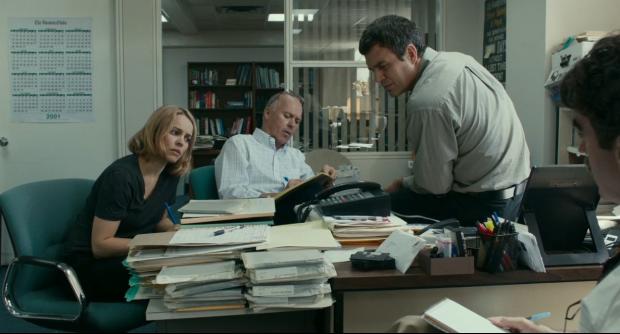
Reporters at work: Spotlight nails the look and feel of a U.S. investigative team. Photo: Open Road Films.
Spotlight is without a doubt the most compelling, most insightful movie on investigative journalism since All the President’s Men, the 1975 classic on the Watergate Scandal. This is great story-telling that takes viewers inside the Spotlight investigative team at The Boston Globe as it dived into one of the more notorious crimes of our time – the systematic tolerance and cover-up of thousands of cases of pedophilia by the Catholic Church. At a time when investigative journalists are under fire around the world, here is a public tutorial on why in-depth, watchdog reporting is so important to social accountability and democracy.
For their dogged work, the Globe team justly earned a Pulitzer Prize for Public Service back in 2003. And now, 12 years later, the movie is winning rave reviews and being talked about for an Academy Award. After a successful release in the United States, next month Spotlight will start to show in a growing number of markets worldwide.
The movie scenes will be strikingly familiar to journalists worldwide who have followed trails of money, people, and accountability. Here are a few highlights that warmed the heart of this longtime reporter and give the public a much-needed, inside look at the craft of muckraking:
The Investigative Sniff: In heavily Catholic Boston, it took a newly appointed executive editor, outsider Marty Baron, to ask for follow-up on a columnist’s report about a molestation case tied to a priest. Baron’s news sense – not something easily teachable – led to an extraordinary investigation. The Spotlight team formed a working hypothesis, that pedophiles were protected within the church to a far greater degree than widely thought, and set about trying to prove it.
Peeling the Onion – in Reverse: In most investigations, you start big and then continually narrow the focus until you have a powerful story – an air-tight case study that can help expose what’s behind a broader issue. But in great stories like the Catholic Church cover-up, you start peeling the onion, but the onion keeps getting bigger and bigger.
Breakthrough Sources: In a big project, there are typically a couple sources who help break open the case, providing key documents and data, the big picture, or a smoking gun. These “Eureka!” moments are perhaps the most exciting parts of the investigation – when you realize your hunch and initial tips were correct. It’s only when the Spotlight team interviews a mental health researcher who studied the problem for years that they realize the sheer scope of the story – that it extends to thousands of clergy and even larger numbers of victims worldwide.
The Trail of Accountability: Marty Baron, the Globe’s new editor, inherited the traits of America’s great muckrakers of old. He tells his reporters and editors that proving single cases of molestation is not enough; he wants to know if pedophilia within the church is a systematic problem, if there is a cover-up, and who should be held accountable. These are the classic questions of investigative journalism. As a U.S. senator famously asked during the Watergate Scandal, “What did the President know and when did he know it?”
Data and Documents: Note the Spotlight team’s methodical search of news stories and court filings, and of annual archdiocese directories which listed priests transferred or absent for unexplained reasons. As the team assembled the data, what did the reporters do? They built a database. Journalists: learn to use a spreadsheet!
The Fight within the Newsroom: Often one of the toughest fights is within your own newsroom, to get the time and resources to tackle such a big story. Globe editors in the past had buried stories on church pedophilia and were skeptical that the Spotlight story could be so big. How did the reporters get so far? First, they had leadership in editor Baron, who knows a great story when he sees one. Equally important: the team delivered the goods and earned the right to keep digging.
Work in a Team: The Spotlight unit worked as a team, so important in reporting on difficult issues. Reporters bring different skills –reporting, sourcing, interviewing, writing – and you need to utilize such a diverse group when confronted with complex issues and powerful institutions like the Catholic Church in Boston.
The Journalism of Outrage: An emotional peak of the movie occurs when reporter Mike Rezendes, played brilliantly by Mark Ruffalo, sees the story getting delayed and explodes in anger. Such emotions are hard to deal with in the newsroom, but that kind of outrage — that “fire in the belly” — is the stuff of great investigators. There is a moral compass to investigative journalism, and that’s why the field attracts men and women who want to right wrongs, stick up for the dispossessed and forgotten, and stop abuses of power. That’s journalism at its very best.
Interested in more? Here’s a look by The Boston Globe at how the movie got made, with links to some of the paper’s original coverage.

David E. Kaplan is executive director of the Global Investigative Journalism Network. He has worked as an investigative journalist for 35 years, reported from two dozen countries, and won or shared more than 25 awards. He is former director of the International Consortium of Investigative Journalists and chief investigative correspondent for U.S. News & World Report.
